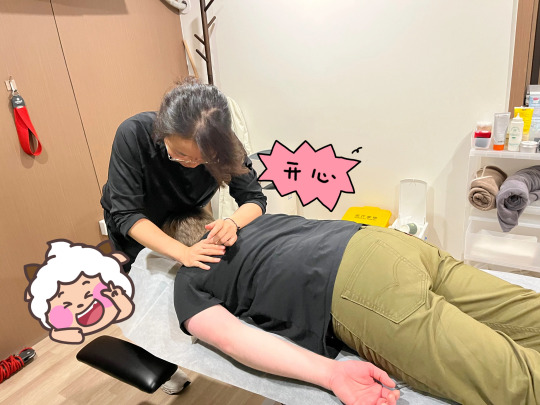#neck and shoulder pain
Text
Physical Therapy Clinic in New York City
Ehlers-Danlos Syndrome - Joint instability
Joint instability is a common symptom in various subtypes of Ehlers-Danlos Syndrome (EDS). It occurs due to the inherent weakness and laxity of the connective tissues, including ligaments and tendons, which are responsible for providing stability to the joints. Here are some strategies to manage joint instability in EDS:
Physical Therapy: Working with a physical therapist experienced in managing EDS can be highly beneficial. They can design an exercise program to strengthen the muscles surrounding the affected joints, which helps provide additional support and stability. The focus is often on low-impact exercises, such as swimming or cycling, to improve muscle tone without excessive joint stress.
Joint Protection: Learning proper body mechanics and techniques to protect the joints is important. This may involve avoiding or modifying activities that put excessive stress on the joints, using assistive devices like braces or splints for added stability, and learning techniques for joint relocation in case of dislocations or subluxations.
Strength Training: Strengthening the muscles around the affected joints can help compensate for the inherent joint laxity. Resistance exercises targeted at specific muscle groups can enhance joint stability and reduce the risk of dislocations or subluxations. However, it is crucial to work with a knowledgeable physical therapist or exercise specialist to ensure exercises are appropriate and safe for your specific condition.
Joint Bracing or Taping: External support, such as bracing or taping, can provide additional stability to the affected joints. These devices can help limit excessive joint movement, reduce the risk of dislocations or subluxations, and provide proprioceptive feedback to improve joint position sense.
Lifestyle Modifications: Making certain modifications to daily activities can help reduce joint stress and minimize the risk of injury. This includes using ergonomic tools and adaptive equipment to decrease joint strain during tasks, pacing activities to avoid overexertion, and practicing good posture and body alignment.
Orthopedic Consultation: In some cases, orthopedic consultations may be necessary to assess joint stability and explore potential surgical interventions for severe joint instability or recurrent dislocations. Surgical options may include ligament reconstructions, joint stabilizations, or other procedures aimed at improving joint function and reducing instability.
Remember to consult with a healthcare professional experienced in managing Ehlers-Danlos Syndrome to determine the most appropriate strategies for your specific situation. Each person with EDS is unique, and a personalized approach is essential for effectively managing joint instability and minimizing associated risks.
EDS stands for Ehlers-Danlos Syndrome, which is a group of rare genetic disorders affecting the connective tissue in the body. To diagnose EDS, a doctor will typically begin with a physical exam and review of the patient's medical history. They may also order genetic testing to look for mutations in genes associated with EDS.
The physical exam may involve testing the flexibility of the patient's skin, checking for joint hypermobility, and looking for other physical signs of EDS, such as scarring or easy bruising. The doctor may also perform imaging tests, such as MRI or CT scans, to evaluate joint and tissue damage.
There are currently 13 subtypes of EDS, each with its own specific diagnostic criteria. A doctor may use a combination of clinical and genetic testing to determine the subtype of EDS that a patient has.
It is important to note that EDS is a complex condition and can be difficult to diagnose. If you suspect that you or a loved one may have EDS, it is important to consult with a doctor who is knowledgeable about the condition and can provide appropriate testing and treatment.
#physical health#physical therapy#ehlers danlos syndrome#ehlers danlos syndrome physical therapy#hypermobile ehlers danlos#physical therapy for ehlers danlos syndro#neck and shoulder pain#ehlers danlos syndrome threatment#heds
4 notes
·
View notes
Text
5 Common Causes of Neck and Shoulder Pain (And How to Relieve Them)

Neck and shoulder pain are more common than you might think, and they can truly disrupt your daily life. Whether it’s caused by poor sleeping habits or carrying a heavy bag, these everyday actions often lead to discomfort or long-term issues if not addressed. Below, I’ll walk you through five frequent causes of neck and shoulder pain and some effective ways to relieve them— including the benefits of using a Shiatsu neck and shoulder massager and I would recommend the one I use also.
1. Sleeping in Awkward Positions
Getting a good night’s sleep is essential for your overall health, but sometimes you wake up with an aching neck, which can make the rest of the day unpleasant. Poor sleeping positions, like lying on your side with your head twisted or using an unsupportive pillow, can lead to muscle stiffness.
Solution:
To avoid this, make sure to sleep on your back or in a position where your head and neck are aligned with your spine. Opt for a supportive pillow that holds your neck in a neutral position. If the stiffness lingers, a Shiatsu neck and shoulder massager can work wonders by loosening tight muscles and improving blood flow helping you recover after a bad night’s sleep.
2. Overhead Work During House Chores
Tasks that involve reaching overhead, like cleaning gutters or painting walls, can strain your neck and shoulders. Holding your head in an awkward, upward-tilted position for extended periods fatigues the muscles and can result in discomfort.
Solution:
Take regular breaks and stretch your neck, rotating your head gently from side to side. After completing housework, a snap on shiatsu neck and shoulder massager can be incredibly effective in reducing muscle tension and providing targeted relief to sore areas. These massagers mimic the pressure of a traditional massage, helping to soothe strained muscles and speed up recovery.
3. Lifting Children (Or Heavy Objects) Incorrectly
Whether you’re lifting your child or carrying heavy shopping bags, poor lifting form can wreak havoc on your neck and shoulders. If you bend at the waist instead of the knees, you’re more likely to experience strain that leads to pain.
Solution:
The right technique is essential—always bend your knees and keep heavy objects close to your body to avoid stressing your spine. After a strenuous day of lifting, a Shiatsu neck and shoulder massager can be a lifesaver. It kneads the muscles, reducing tightness and helping to relieve the tension that builds up after carrying heavy loads.
4. Poor Posture While Working
Let’s be honest: most of us spend our workdays hunched over a desk, which places a heavy load on our neck and back muscles. Over time, this poor posture can lead to stiffness and chronic discomfort.
Solution:
Try to set up your workstation properly, with your computer monitor at eye level, and take standing breaks every hour. Alongside these adjustments, using a Shiatsu neck and shoulder massager can help alleviate the tension caused by poor posture. The deep-tissue action of these massagers, such as the Elpiana Neck and Shoulder Massager, targets stiff muscles and promotes relaxation, making it an excellent tool for office workers dealing with neck and shoulder pain.
5. Carrying Heavy Shoulder Bags
Many of us carry shoulder bags packed with all sorts of essentials. But that heavy load, especially if carried on one side, places stress on the neck and shoulder muscles. Over time, this can result in wear and tear that manifests as pain.
Solution:
Switching to a backpack distributes the weight evenly across your back, minimising strain on the neck and shoulders. If backpacks aren’t your style, be sure to switch shoulders frequently and try to reduce the weight of your bag. After a long day, using a Shiatsu neck and shoulder massager can be a great way to unwind and soothe tired muscles. These massagers help relieve pressure points and encourage blood flow, reducing the risk of long-term issues.
The Benefits of Neck and Shoulder Massagers for Pain Relief
Neck and shoulder massagers, especially Shiatsu-style massagers, are fantastic for relieving pain and stiffness. They provide deep tissue pressure, helping to relax the muscles and improve circulation. Whether you're dealing with soreness after a day at the office or muscle fatigue from heavy lifting, a neck and shoulder massager can offer soothing relief without the need for frequent physio appointments.
Conclusion:
Neck and shoulder pain are often caused by everyday habits that we might overlook. Simple changes—such as improving your posture, lifting objects correctly, and ensuring you sleep in a supported position—can prevent discomfort. Additionally, Shiatsu neck and shoulder massagers provide an excellent, non-invasive way to alleviate pain and muscle tension. With devices like the Elpiana Neck and Shoulder Massager, you can target pain points, reduce stiffness, and promote overall muscle recovery.
1 note
·
View note
Text
Neck and shoulder pain can greatly affect your daily life, making even simple tasks feel overwhelming. While conventional treatments like medication and physical therapy are common, acupuncture for neck and shoulder pain offers a unique and highly effective alternative.
1 note
·
View note
Text

Cervical Neck Traction Pillow
Help relief neck pain in just 10 minutes a day. The neck stretcher is intended to be used for people who are Prolonged bowing your head, sit still for along time, improper sitting posture, stiff neck, help relieve neck pain and pressure, help restore neck curve naturally.
The neck and shoulder relaxer is ergonomic design, the curve of neck relaxer matches the cervical spine. When you lie down, it offers vertical, horizontal support, and Curvature stretch for neck traction, allowing the cervical traction pillow to position the head to reduce spinal pressure, support the cervical spine and help restore the C-shaped curve of the neck. “Buy now and enjoy a shopping experience that oozes quality and comfort!”
#neck and shoulder relaxer cervical traction device#neck and shoulder relaxer#neck and shoulder relaxer pillow reviews#devices for neck and shoulder pain#neck and shoulder relaxer pillow#neck shoulder relaxer traction cervical#neck and shoulder relaxer review#neck and shoulder relaxer reviews#neck and shoulder pain#neck and shoulder relaxer uk#best neck and shoulder relaxer#cervical traction device#cervical traction#neck and shoulder relaxer cervical traction
1 note
·
View note
Text
Relief at Your Fingertips: The Best Massage for Neck and Shoulder Pain with Kahuna Massage Chairs
Neck and shoulder pain can be debilitating, affecting our daily lives and overall well-being. Finding effective relief becomes paramount, and one solution gaining prominence is the use of Kahuna Massage Chairs. These innovative chairs offer targeted and soothing massages, specifically designed to alleviate the tension and discomfort associated with neck and shoulder pain.
Kahuna Massage Chairs stand out for their intelligent design and advanced technology. Equipped with specialized massage programs, these chairs employ a combination of techniques such as kneading, tapping, and shiatsu, precisely targeting the muscles in the neck and shoulders. The result is a therapeutic experience that helps reduce muscle tightness, improve circulation, and promote relaxation.

What sets Kahuna Massage Chairs apart is their commitment to user customization. With adjustable settings, users can tailor the massage intensity, speed, and focus to address their specific pain points. The chairs are also equipped with body scanning technology, ensuring that the massage is tailored to the user's unique body shape and size, delivering a personalized and effective treatment.

Regular use of Kahuna Massage Chairs for neck and shoulder pain can have long-term benefits. Beyond immediate relief, these massages contribute to improved flexibility, reduced muscle stiffness, and enhanced overall mobility. The convenience of having this targeted relief at home, without the need for external appointments, makes Kahuna Massage Chairs a practical and efficient solution for individuals seeking relief from neck and shoulder pain.
Investing in a Kahuna Massage Chair is an investment in your well-being. Experience the transformative power of targeted massages designed to alleviate neck and shoulder pain, providing a path to relaxation and improved physical health from the comfort of your own home.
0 notes
Text
youtube
Massage therapy is recognized as an integral component of the health industry, and is utilized for various back pain problems. A majority of doctors advise their patients to get physical therapy as a supplement to medical treatment. For more details visit at https://www.eastleighsportsmassage.co.uk/
#Sports Massage Hampshire#Deep Tissue Massage#Neck And Shoulder Pain#Remedial Massage#Sciatica#Lower Back Pain#Shoulder Pain#Neck Pain#Rsi#Sports Massage#Repetitive Strain Injury#Trapped Nerve In Neck#Stiff Neck#Youtube
0 notes
Link
Not all pains can find relief with massage, but massage can help. Stagnated lifestyle has been the most popular cause for pains and discomfort in the body leading to conditions like Sciatica where the nerve passing from the spine to the feet is irritated. For more Details Visit at https://www.eastleighsportsmassage.co.uk/
0 notes
Text
Shoulder pain from sitting at a desk? Really?
Isn’t shoulder pain usually related to sports-related activities? How can something so inactive cause shoulder pain?
Sitting at a desk, whether it’s working for hours at a time or for shorter periods at home, can cause troublesome pain in your shoulders.
There are many ways to relieve your shoulder pain and strengthen your body—that’s good news for those of us whose jobs require us to sit at a desk and work on a computer for eight or more hours a day.
In this article, you’ll learn about what causes shoulder pain while working at a desk and what you can do to reduce that pain.
Table of Contents
Why Do My Shoulders Hurt From Sitting?
Can Sitting at a Desk Cause Shoulder Pain?
What Causes Shoulder Pain From Sitting at a Desk?
How Can I Relax My Shoulders at My Desk?
5 Ways to Reduce Shoulder and Back Pain From Sitting at a Desk
6 Exercises That Can Help Relieve Shoulder Pain From Sitting at a Desk?
How Physical Therapists at PRO-PT Can Help Relieve Shoulder Pain From Sitting at a Desk
Why Do My Shoulders Hurt From Sitting?
This question can be answered with one word—posture.
Poor posture while sitting is one of the leading causes of shoulder pain.
So what causes this pain while sitting? Factors contributing to postural pain include…
Working on computers
Talking on phones
Slouching
Sedentary lifestyles
Studies show that most people’s muscles start to fatigue after just 15 minutes in an upright position.
Can Sitting at a Desk Cause Shoulder Pain?
Doctors may focus on neck and back pain caused by poor posture, but sitting at a desk can indeed cause shoulder pain.
Oftentimes shoulder pain is overlooked because the pain can be disguised as coming from the back or neck. Working at a desk can create a change in balance to the shoulder, resulting in pain in that area.
What Causes Shoulder Pain From Sitting at a Desk?
Americans sit at desks more than any time in history, and we are paying the price physically.
Shoulder and back muscles are often weaker than our frontal body muscles because of:
Extended sitting
Prolonged work on computers
Repeated phone use
Sedentary lifestyles
All of these are factors that keep the rotator cuff in the shoulder from properly working, resulting in strain and discomfort.
In addition, repetitive strain injury (RSI), also known as cumulative trauma disorder, can be a cause of chronic shoulder pain. This condition is caused by frequent, extended, and repetitive movements that can put pressure on the tendons and muscles of the upper body.
Some common movements that can cause RSI include:
Typing on a computer
Using a computer mouse
Awkward posture or sitting position
Shoulder pain from sitting at a desk can also be masked by neck or back pain. That’s why it’s extremely important to have a proper assessment to find out where the pain is coming from.
The physical therapists at PRO~PT are specially trained to perform a proper and thorough assessment to determine what is causing your pain. Treating the source of your pain and not just the location will give you the lasting relief you are longing for.
How Can I Relax My Shoulders at My Desk?
Stretches, simple exercises, and relaxation techniques can be the key to easing the tension in your shoulders while working at your desk. Take breaks frequently throughout the day to pause your desk activity and do some simple shoulder shrugs.
Sit back in your seat with your feet flat on the floor and your arms relaxed. Take a deep breath in, shrug your shoulders toward your ears and hold them for a few seconds. Slowly let out your breath and lower your shoulders. You can repeat this exercise several times before returning to your desk work.
5 Ways to Reduce Shoulder and Back Pain From Sitting at a Desk
There are many general practices you can adopt to help lessen the shoulder and back pain that comes from long hours working at a desk.
Consider adding the following to your routine:
Regular exercise
Stretching
Yoga
Exercises that strengthen your core
Wear a posture trainer
Maintain a healthy diet
Regular reminders to correct your posture
In addition to these general tips, the following 5 tips can further help relax your shoulder at your desk.
#1: Rearrange Your Workspace
Correct ergonomics can be an important key to lessening the stress your body experiences while working at a desk.
The placement of your chair, the height of the desk, and the height of your computer monitor are important facets of practicing the best desk ergonomics.
Consider the following when arranging your workstation:
Adjust your chair so that your knees are level with your hips.
Strive to keep your pelvis in a neutral position.
Keep your wrists straight and your hands at elbow level.
Place your computer monitor at about an arm’s length away.
Put the monitor at a height that is even with your eyes.
Consider using a footrest.
Avoid reaching for the mouse by keeping it in a position where your elbows are at a 90-degree angle.
Rest your arms on your desk.
Keep the items and tools you use regularly close to you within easy reach.
If you use the phone frequently, consider using it on the speaker or use headphones rather than cradling the phone between your ear and shoulder.
#2: Change Your Position Often
Your best posture is your next posture.
Our posture naturally worsens the longer we sit at our desks, so that’s why it’s important to alter our seated positions often throughout the day.
This can easily be done by sitting on the chair and leaning back before going back to a proper seated posture.
Or better yet, get up and move around.
Walk to the breakroom to fill up your water bottle or take that message verbally to your coworker rather than sending a quick email, and then come back to your desk and reset your posture into a comfortable and correct position.
#3: Practice Good Posture
“Sit up straight. Don’t slouch. Keep your feet on the floor.” We’ve all heard these reminders from our well-meaning moms or teachers.
You hate to admit it, but they’re right. Training ourselves to keep good posture will have long-lasting benefits and less shoulder pain.
So what does good posture look like at your desk?
Feet on the floor or a footrest
Knees level with your hips
Forearms parallel to the ground and your shoulders relaxed
Legs uncrossed
Back supported with your chair or a back support
Elbows close to your body
Supported thighs and hips
#4: Consider a Standing Desk
Standing desks are more popular than ever and for good reason. Standing while working can take the strain off of many parts of your body, including your shoulders.
Not only that, working at a standing desk has many other health benefits like:
Avoiding weight gain
Losing excess weight; and
Blood sugar levels returning to normal faster after meals
If you decide to change to a standing desk, consider the following:
Ease yourself into it by working for 30 to 60 minutes at a time. Easing into it will allow your body to gradually get used to the new position.
Get an adjustable desk so that you can move it to a sitting position for tasks that are more easily and efficiently done while seated.
Pay attention to your posture, even while working at your standing desk. Working at a standing desk with bad posture may end up with you trading one problem for another.
#5: Take Plenty of Breaks
It’s easy to get in the zone at work and forget to take breaks, but we all need them.
Taking a break every once in a while not only resets our mental capacity, but it also gives us a chance to reset our physical bodies.
Every 30 minutes to an hour, get moving by:
Stretching
Taking a stroll around the office
Visit the restroom
Refill your coffee cup
Do whatever it takes to get those moving breaks in—set a timer or leave post-it note reminders near your computer.
6 Exercises That Can Help Relieve Shoulder Pain From Sitting at a Desk?
If you find yourself suffering from shoulder pain from sitting at your desk, there are many exercises you can do to relieve that pain.
Before beginning any of these exercises, it’s always recommended to start slowly and consult your doctor if you experience any pain or discomfort.
#1: Cervical Retraction
Sit up straight.
Pull your head back and as far as is comfortable.
Return to the beginning position and repeat 5 to 10 times.
This is an excellent exercise to help with posture.
#2: Back Stretch
Sit in your chair with your feet flat on the floor.
Reach your hands to cradle the back of your head.
Gently lean back and bring your gaze to the ceiling.
Hold the stretch for a few seconds and repeat.
#3: Armpit Stretch
This stretch might seem a little awkward, so you may want to do this one when you’re alone.
Sit up straight.
Rotate your head so that your nose is just above your armpit.
Hold your head with your hand and gently push it closer to your armpit.
Hold for 10 seconds.
Repeat a few times on each side.
#4: Shoulder Rolls
Chances are you’ve done this exercise many times already. It’s a simple one that can be done at any time.
Sit up straight and tuck in your chin.
Roll your shoulders forward, up, back, and down in a circular motion.
Repeat several times and then reverse and do them backward.
#5: Upper Trap Stretch
Sit up straight and tilt your head sideways toward your shoulder.
Hold for 10 seconds.
Repeat on each side.
Click here to see how to enhance this stretch.
#6: Chin Tuck
This is a simple exercise that can be repeated often.
Sit up straight, looking forward.
Lower your chin to your chest and hold for 15 to 30 seconds.
Return to the starting position and repeat.
Let the Physical Therapists at PRO~PT Help Relieve Your Shoulder Pain From Sitting at a Desk
At PRO~PT we specialize in the evaluation and treatment of:
Orthopedic injuries
Sports-related injuries
Spine conditions
Post-surgical care
Balance and fall prevention
And more
Our licensed therapists provide quality and innovative care to our patients to get them back on their feet to enjoy their lives to the fullest.
We have many locations throughout the Central Valley, including Fresno, each with a unique staff with knowledgeable and friendly faces ready to serve you and your physical therapy needs, whether from shoulder pain or pain from extensive injuries.
0 notes
Text
How do you relieve your shoulder pain?
The most scientific arm exercise method!
If your shoulders are in pain, you can get some massage and exercise. When you exercise more and more, you will get big muscles and a good figure. You can get rid of frozen shoulders. It has always been the dream of many people to have strong power, which means that your ruler has great power, and you will be stronger.
How to continuously train is also a step before us. Long and slender posterior coracoid muscles, and only one slender long arm — the triceps.

For the front side of the arm, most people will focus on the biceps. This is because the brachialis is a deep muscle, and our training effect on it will not be very obvious in the muscle. And the function of the brachialis is only elbowed flexion, so it can be effectively trained when training the biceps brachii, which has more functions and cooperates with the brachialis.

Curls — is the most important biceps extension exercise. Either way is the most effective form of curling, with a core-loaded elbow flexion that stimulates our extended biceps. Choose a movement that you like and that works well for progressive overload, with heavier, lower reps for the biceps long.

And if you say that you want to promote growth, it also needs such a process. In short, your operation process is not simply lifting a part, including putting the weight back with some help.

Different grips will also have different training effects. Both the positive grip and the hammer grip can have a strong stimulation of the biceps, but if you put your palms down during the curl, then you are right. Activation of the biceps is greatly reduced. And instead, stimulation of the brachialis deep in the forearm is increased.
It should be noted that the distance of the triceps is very long to the distance. It is very narrow to cross the narrow distance, which is under the over grip. You push the action restrictively, and it is easy to cause joint strain on the wrist.
If you want to optimize your training results, you can also add elbow extensions for shoulder extension, such as the triceps press, and the back of the neck. This works more deeply on the short and long heads of the triceps.
You want to have a small program. You should train continuously. You can believe that you can achieve your goals.
To know more: https://www.fanwer.com/blogs/news
0 notes
Text




Butcher's hands on Hughie | The Boys S02E06
#jack quaid#karl urban#hughie campbell#billy butcher#butchie#cara gifs#ohhhh yeah#blood tw#injury tw#i had to do this one again#and again#unhinged tags to follow#butchers hands on hughie thoughhhhh#hughie curling in against butchers neck#THE HAND ON THE SHOULDER#griping hughie so tightly pulling him closer#like ohhhh my god daddy we get it#you'd take his place if you could#the pained wince jesuschrist#THE WHIMPERING#the whump#[chefs kiss]#it's free whump estate#oh god do i ever have a type#mmm also#the matted with blood happy trail#i'm
1K notes
·
View notes
Text
Physical Therapy Clinic in New York City
What Is Ehlers-Danlos Syndrome?
Ehlers-Danlos Syndrome (EDS) is a genetic disorder of connective cells that can influence the body in different ways. EDS is normally defined by joint hypermobility (think of joints that are extremely flexible and move in a much greater range than normal), joint instability, dislocations (when there is a split on the surface areas of a joint), and scoliosis. While there are other symptoms like joint deformities, skin hyperextensibility, and abnormal scarring that are present in people with EDS, this article will focus on Hypermobile Ehlers-Danlos Syndrome (hEDS).
hEDS is the hypermobility type of EDS and is believed to be the most common. Unfortunately, there is not much research to tell us precisely just how frequently it occurs. But it can be inherited from a mom and dad that carry the same gene. Alternatively, someone can be born with a brand-new anomaly, meaning that the problem is happening in their household for the first time.
Part of the reason it’s so frustrating for people with EDS to get answers is that there is no simple test for EDS. For example, your doctor can’t just take your blood and send it to a lab. To diagnose it, a doctor needs to look for joint hypermobility, indicators of malfunctioning connective tissue throughout the body (e.g. skin attributes, hernias, prolapses), a family history of the condition, and bone and joint problems. There are numerous linked signs and symptoms but they can also be the results of something else (not necessarily EDS), which makes it all the more difficult to identify. A geneticist must often be consulted to confirm a diagnosis of EDS.
This is why so many people don’t actually meet the diagnostic standards for hEDS… even though their hypermobility creates a lot of issues like pain and discomfort.
You may experience discomfort and dislocations, be prone to injury, have curvature of the spine, and have degenerative joint and bone disease. People with these symptoms may have many signs that point to EDS, however, they don’t meet the “criteria” to be diagnosed with EDS. This is why it can often take so long to actually get a diagnosis. A primary doctor may not know what exactly is going on because the tests come back “normal.” You may then go to several other specialists before finally being told you have EDS.
Joint hypermobility is currently identified on a spectrum. At one end is simple hypermobility, which doesn’t have any signs or symptoms. And at the other end is hEDS. If you have something in between, that’s called Hypermobility Spectrum Disorder (HSD).
If you have HSD or hEDS, the treatment and recommendations are usually very similar or the same.
Sometimes, a “provisional medical diagnosis” of EDS is made. This can happen if you meet some requirements but don’t have access to a geneticist who can confirm. In this case, if your doctor or physical therapist thinks you have EDS, they may recommend specific types of treatment that will help you with your symptoms before you can confirm the diagnosis. Many people will often start feeling better with physical therapy before getting the “official” EDS diagnosis.
Please keep in mind everyone’s experience with EDS is different. EDS can present with so many different symptoms, and the treatment path will usually vary depending on your specific case. It is crucial to avoid any doctor, or EDS physical therapist that has a one size fits all approach when it comes to treatment.
What are the symptoms and signs of Ehlers-Danlos Syndrome?
Pain and exhaustion are practically universal for people who have EDS. But remember, that is usually coupled with hypermobile joints and skin issues. For Joints, this can include:
Joint pain and deformity; muscle pain and nerve pain; loose/unstable joints; muscle stress; weakness of the throat; pelvic floor weakness; and nerve conditions (neuropathy).
Symptoms with the Skin can include:
Soft velvety-like skin; variable skin hyper-extensibility; breakable skin that tears or bruises easily; serious scarring; slow or incomplete wound healing.
#hypermobile ehlers danlos#physical therapy#shoulder pain#physical health#neck pain#knee pain#neck and shoulder pain#back pain#knee pain relief#back pain relief#chronic fatigue#eds symptoms
4 notes
·
View notes
Text
Here's 3 minutes of Katya and Trixie acting like an old married couple
#speaking for the other#finishing each other's sentences#saying the same thing at the same time with the same gestures#telling a story together#casual physical affection#including a gentle foot kick#Trixie giving i am baby help me daddy#and katya giving fond exasperation at Trixie doing her terrible trump impression#all the same references#watching Tammie during this was like whenever they jointly interact with another ru queen#where the queen is looking at them like wow okay lesbians#Trixie mattel#katya#katya zamo#trixie and katya#the brians#the bald and the beautiful#grabby hands#lesbian dads#this video took me way too long but once I'd commited to it i had no choice but to finish it#special guest star Katya's Boston accent saying Elizabeth AH-DEN#you know trixie bought her those hideous red Camper shoes for her birthday#supportive besties#lezzing out#very compatible#the most husband sentence in this 'remember when I said that to you'#also Trixie flexing her neck and rubbing her shoulders and her knee is so relatable#shout out to chronic pain suffers
174 notes
·
View notes
Text

(source) i have been laughing at this for so long. i think he is cute



I THINK HE IS SO CUTE !!!!!!
#sorry it's a sunday and im spending it looking at back of patrick back so cute. obviously#flat ass man i need to bury my face in his lower back so bad i mean what#the description seems to say he had shoulder and neck muscle pain im willing to bet he spends all his time shrimping at his workstation#media blitz#patrick stump
193 notes
·
View notes
Text

in case of emergency, break glass
...or, uh.... maybe we should look at leon's files, first....
(the many directional scars -> when he was protecting ada from simmons)
#resident evil#leon s kennedy#mind control au#digital art#i am... so fuckin happy with this sketch#his hips kinda bother me still but mfer his left hand <3#my body pain is the inspo#upper back neck shoulder but i had to put the device in a place with the least movement for him#the idea of nodes being installed into his head just... originally his hair was supposed to cover it on the sides of his head#that was not a hair clip in the other piece it was the node things#changed the cuffs to gloves (they are still screwed into him)#sure i said he needed to be more 'aesthetic' with minimal attachments BUT LISTEN#inspired by zane borderlands' multiverse bandit skin too.... ahahehh#but yeah i think breaking the glass might actually work? not easy whatsoever tho...#a gun would be the best bet of breaking that but you think chris is willing to risk that?#throwback to his old hair -> [redacted]'s request owo#body horror#scars#surgery
135 notes
·
View notes
Text
drawing Barnaby is incredibly Detrimental to my health because it consistently finds me like this:

#MY NECK HURTS <3#i'll Realize. fix my posture#lose myself in the Love and then BOOM shrimping once more#i hunch over my tablet face To The Screen like some wild beast defending its kill#but with... Delight and Whimsy instead of bloodthirsty viciousness#shoulders hunched back Curled head down and jutted forward-#snf sob... love truly is pain....#absolutely unprompted#THERE'S NO NEED FOR ME TO SIT LIKE THISSSSSS#I JUST GET SO ABSORBED!!! HE'S SO!!!!#completely related but there isn't enough Handsome Barnaby art#well. every image of him is handsome in my professional opinion#but you know what i mean!!!!#i need to put him in outfits....#no. you know what i need?#a very very tiny pixelated image of him framed and hung on my wall#tiny frame. tiny barnaby. really just like. three blue pixels#that way when i wake up in the mornings i can look over and see The Pixels#and be filled with enough strength to Get Up#i need the motivation to get out of bed... i have been sleeping until 3 every day....#methinks. tis not healthy#but yes. tiny barnaby in a frame please and Thank You!
89 notes
·
View notes